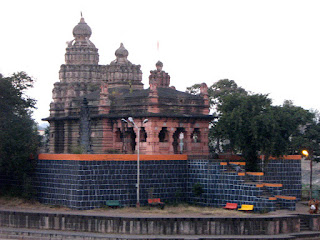Changavateshwar temple
Venue: Saswad, 40km from Pune.
History: This temples Shivlinga was said to have been originally installed by Sage Changadeva(12th/13th cen AD). Jeernoddhar of temple by Sardar Ambuji Purandare in 1700 AD.
Sangameshwar temple, Saswad. Built at the confluence of the Karha and Chamli rivers.
Photographs : Abhijit Rajadhyaksha
Venue: Saswad, 40km from Pune.
History: This temples Shivlinga was said to have been originally installed by Sage Changadeva(12th/13th cen AD). Jeernoddhar of temple by Sardar Ambuji Purandare in 1700 AD.
Pic:shikhara
pic: mandovara
Pic:sthambha shilpa depicting Sharabha
Note: Temple walls & pillars have carvings depicting Gods,Godesses,Celestial beings, stories from ancient texts etc.
Note: Temple walls & pillars have carvings depicting Gods,Godesses,Celestial beings, stories from ancient texts etc.
Pic:Deepamala
Pic: Nandi placed in the antarala
Pic: sabhamandapa
pic: garbhagriha doorframe as seen from the vestibule
pic:sthambha shilpa
pic: a woman churning curds
pic:malayuddha shilp
pic:Vanar shilp
pic: Sharabha shilpa
pic:dancing Apsaras
pic: Mayur shilp
Sangameshwar temple, Saswad. Built at the confluence of the Karha and Chamli rivers.
Pic: Samadhi of Peshwa Balaji Vishwanath Bhat
pic:Nandi
pic:shikhara
Pic:temple shikhara & mandovara
pic:shikhara of an adjoining minor temple
pic: Nandi seated in the sabhamandap
pic:rest rooms
pic: Sangameshwar temple is built alongside the confluence of Karha & Chamli rivers
pic:rearside minor temple
pic: Nandi outside a minor temple behind Sangameshwar
Pic:Godaji Jagtaps samadhi outside Sangameshwar temple Saswad.Godaji Jagtap had struck down Muse Khan, second in command of Fateh Khan (Adilshahi commander) when the latter had attacked fort Purandar.






































































